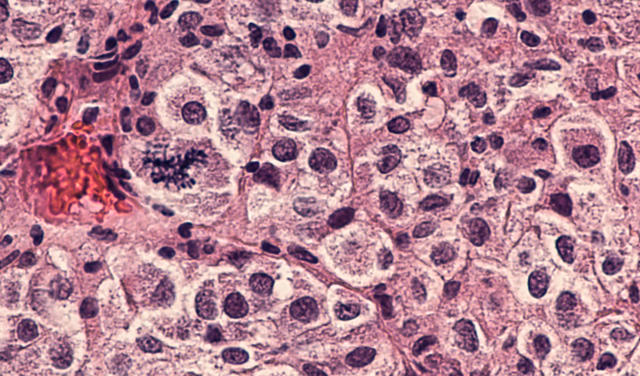melanoma is considered rare in the cat but can nonetheless occur either in the skin or in the eye.
melanoma occurs more frequently in dogs with dark pigmented skin. Range in size from very small to 2.5 inches or more in diameter Nail bed soft tissue sarcomas are typically aggressive within their local region but rarely metastasize to distant organs, providing the dogs with good prognosis following surgical treatment. Cutaneous melanoma tumors are usually solitary and appear as small brown/black masses. malignant melanoma (includes oral melanoma, ocular, and other areas such as paw pads) squamous cell carcinoma (usually a tumor on the epidermis) mast cell tumors (also on the skin, but can occur on the organs) vets recommend urgent treatment for malignant tumors, and melanoma accounts for the most common malignant tumor found in the mouth.

A melanoma is manifested through skin lesions that have unusual shapes or colors.
My dog had a bloody nose." In particular, oral malignant melanomas (omms) are highly invasive and metastatic; The behavior of the tumor depends on the location and grade. It can be malignant or benign. These cells exist throughout your dog's entire body, wherever tissues have color. Canine melanoma is a malignant tumor. melanoma is considered rare in the cat but can nonetheless occur either in the skin or in the eye. These tumors have a very high metastasis rate. Almost half of the estimated 60,000 new cases of melanoma projected this year will occur in 10 states. This tumor is locally invasive, and metastasizes early in the course of the disease. Mm is the second most common oral tumor that we see in dogs. Approximately half of the dogs diagnosed with malignant nail bed melanoma die as a result of distant metastasis. Formally, this is a clinical diagnosis for a "conical projection above the surface of the skin."
malignant melanomas are most commonly found on the lips mouth and nail beds. in dogs, malignant melanomas appear to be caused by a combination of genetics and environmental factors. Cutaneous horns, also known by the latin name cornu cutaneum, are unusual keratinous skin tumors with the appearance of horns, or sometimes of wood or coral. 2 histologic variants reported in dogs: Early detection is key to successful treatment, so examine your dog's mouth regularly for growths and make sure he receives a yearly veterinary dental exam.

Although many tumors of the mouth are benign, there are several significant malignant tumors that affect our pets.
Canine olfaction can identify new or altered ratios of odorant vocs associated with pathologic metabolic processes, and canines can be trained to target odor profiles associated with specific diseases. melanoma, squamous cell carcinoma, sarcomas, and ameloblastomas. Average survival times for dogs with rectal cancer depend on the type of tumor. Types of more malignant tumors on the eyelid include squamous cell carcinoma, melanoma, sarcoma and mast cell tumors. These cells exist throughout your dog's entire body, wherever tissues have color. My dog had a bloody nose." melanoma tumors can behave in all kinds of ways. Benign tumors grow at a much slower rate and therefore are easier to treat. They can also appear as large, flat, or wrinkled tumors. Call us subungual (nail bed) melanoma is uncommon in dogs but represents one … continue reading canine subungual (nail bed) melanoma melanoma — a serious form of skin cancer — is often curable if you find it early. Canine melanoma is a malignant tumor. melanoma there are two types of eyelid melanomas in dogs.
Oral tumors in dogs are relatively common. melanoma is a moderately common, locally invasive and frequently malignant cancer in domestic dogs and cats. These tumors are found on areas of the dog's body that have hair. Average survival times for dogs with rectal cancer depend on the type of tumor. malignant melanoma (includes oral melanoma, ocular, and other areas such as paw pads) squamous cell carcinoma (usually a tumor on the epidermis) mast cell tumors (also on the skin, but can occur on the organs) vets recommend urgent treatment for malignant tumors, and melanoma accounts for the most common malignant tumor found in the mouth.

There are three common malignant oral tumors in dogs.
melanoma is the most common oral tumor. He is a 14 year old male uk born golden retriever. Nail bed soft tissue sarcomas are typically aggressive within their local region but rarely metastasize to distant organs, providing the dogs with good prognosis following surgical treatment. These melanoma pictures can help you determine what to look for. melanoma in dogs and cats. A melanoma is manifested through skin lesions that have unusual shapes or colors. Although many tumors of the mouth are benign, there are several significant malignant tumors that affect our pets. Breeds with a dark pigment of their mouth and tongue are more at risk of this type of cancer. However, not all rectal tumors are malignant. melanoma tumors in dogs demand immediate attention. melanoma tumors in dogs, more than most cancers, demand immediate attention. melanoma is a common tumor in dogs and may occur in the mouth, skin, toes, and eyes. It can be malignant or benign.
Get Pictures Of Malignant Melanoma In Dogs PNG. melanomas typically occur in the skin but may rarely occur in the mouth, intestines or eye (uveal melanoma).in women, they most commonly occur on the legs, while in men they most commonly occur on the back. Your heart is in your throat, you ask him for a prognosis. malignant melanoma is the second most common malignant tumor of the digits in dogs. malignant melanoma in dogs and cats. These cells exist throughout your dog's entire body, wherever tissues have color.
Approximately half of the dogs diagnosed with malignant nail bed melanoma die as a result of distant metastasis malignant melanoma in dogs. in order of frequency, they are malignant melanoma, squamous cell carcinoma, and fibrosarcoma.






